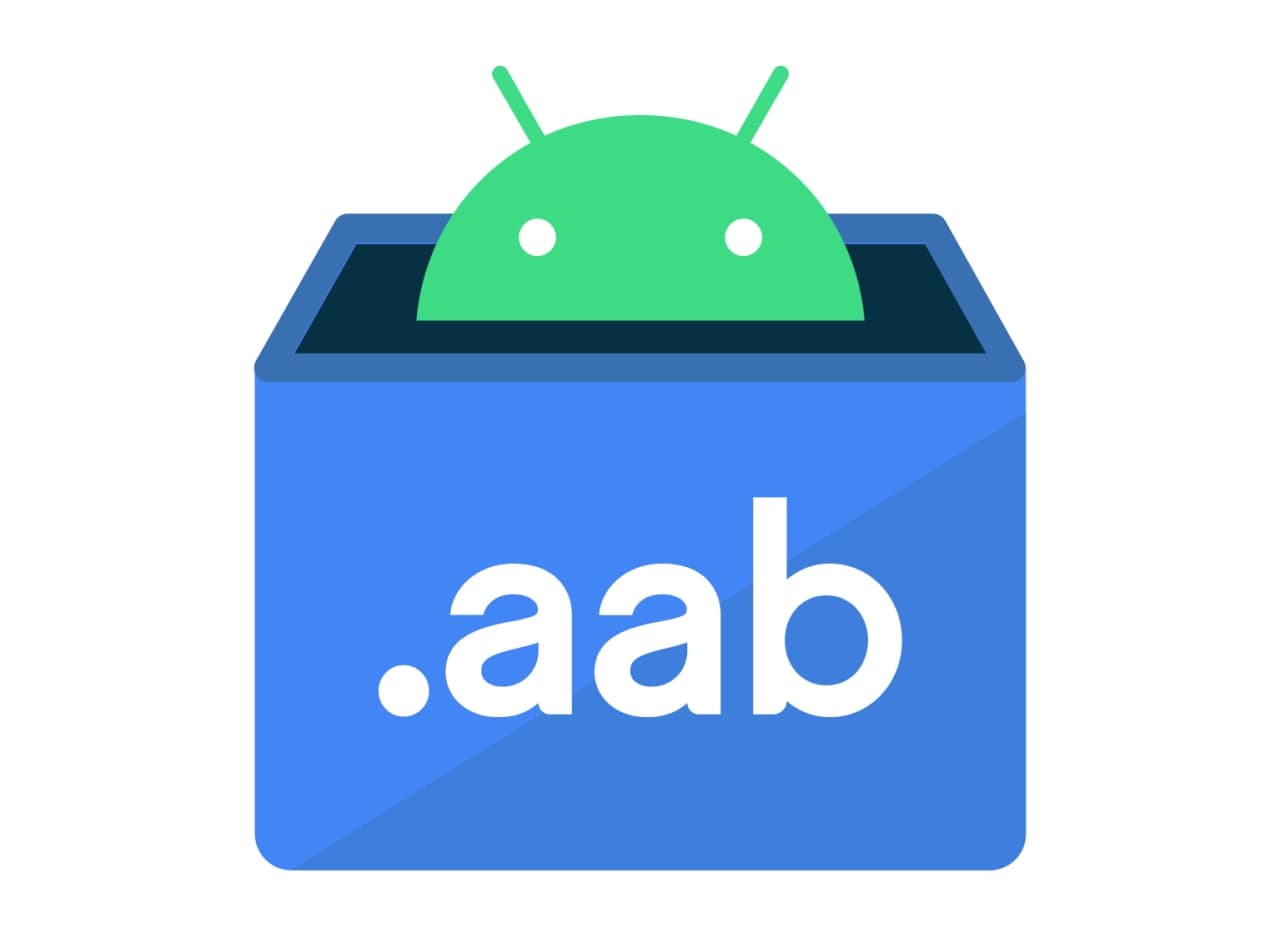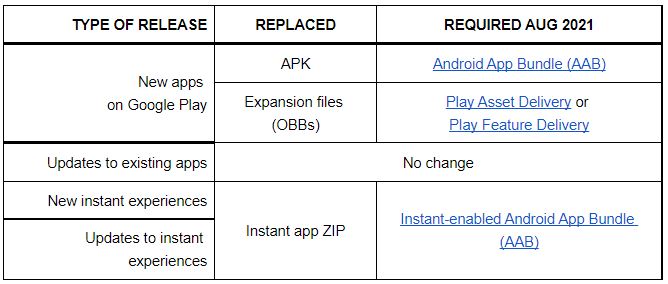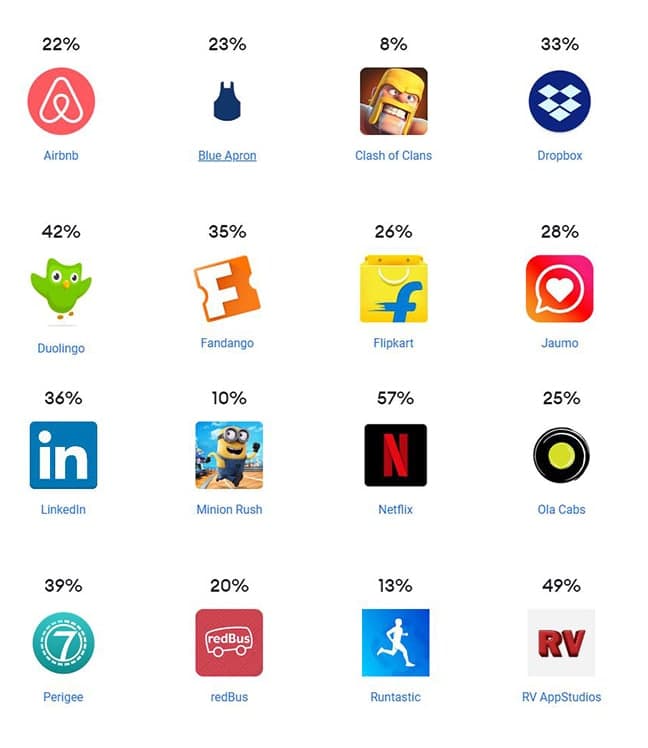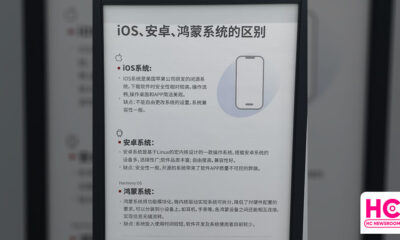Android
AAB (Android App Bundle): Everything about the future of APK
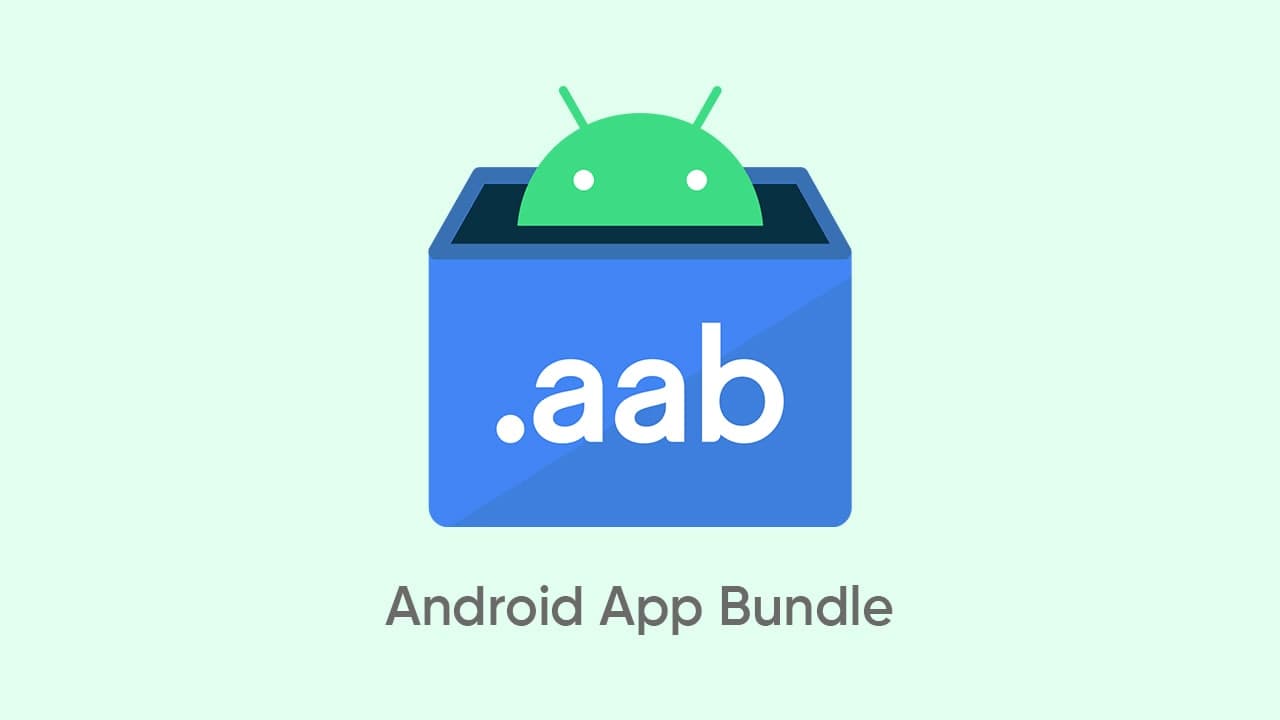
In 2018, Google introduced the Android App Bundle also known as AAB, which is a new publishing app format, delivers more enhanced benefits over another current most popular Android app format – APK (Android Application Package). The AAB offers a smaller app size, high installation rate, easy switching, customizable features, and so on.
Simultaneously, it allows adding multiple feature modules in the app project with the benefits of Play Feature Delivery (PFD). Furthermore, game developers with app bundle formate can use Play Asset Delivery to delivering large amounts of game assets with flexible delivery orders and high performance.
The Android AAB supported in Android Studio version 3.2 or above, Unity 2018.3, 2017.4.17, and Cocos Creator version 2.0.9 or above.
Google is Replacing APK with AAB:
By June 2021, Google made its mind to make AAB the default app package in place of Android Package or APK application format for the Android Apps on Google Play Store. Google believes that this change will bring more efficient working capabilities and faster-operating speed in applications and data delivery.
It means that starting in August of this year, all new and existing apps on Google Play Store must have the AAB format. Meanwhile, it’s not mandatory for the present apps with APK formate at the moment.
What’s changing in August 2021
If we talk about what changes are Google bringing in August 2021, we should look into the following:
- The APK format is replacing with the AAB on Google Play
- The Expansion files (OBBs) will replace with Play Asset Delivery (PAD) and Play Feature Delivery (PFD)
- The AAB will require the Instant app Zip for instant experience
These changes will be applied to the apps or files launching in the future. While the existing apps will remain the same as they before. After August 2021, the files with more than 150MB size can take the benefit of PAD & PFD with AAB format.
AAB Benefits:
Android App Bundle: Benefit from a smaller App
It modifies the serve APKs and optimized them for different device configurations, which results in the smaller app sizes average of about 10% and 15% for universal APK.
Users will only download the used codes in the app with need resources and requirements for an individual device that made the faster downloading speeds with most installed and fewer uninstalls.
Manage releases more efficiently:
The AAB creates a single artifact that consists of all compiled codes, resources, and native libraries for a particular app. Thus, eliminates the need to build, sign, upload, and manage version codes for multiple APKs.
Play Asset Delivery:
This AAB exclusive feature reduces user waiting time and transmits large assets dynamically also reducing delivery costs. Games with Play Asset Delivery can have the benefits of texture compression format targeting. It allows a user to only get required assets suitable for their devices.
Customize Feature Delivery: Faster Build Times
It allows the Android Studio to build systems using Gradle, which are optimized for modular apps so they are significantly faster to build than large solid apps. It reduces the waiting, so developers can give more time to designing, coding, and testing the app.
Using the feature modules, improve build speed, engineering velocity and extensively customize app delivery with reduced app size. However, there are some constraints and edge cases we have to follow when using feature modules.
Google Play Instance Experience:
The AAB offers the Google Play Instant experience, and the bundle is known as an instant-enabled app bundle. This bundle presents the app set up, configure, build, test, and publish guides.
Issues with AAB: Google will have the most control
As I mentioned earlier, the AAB has about 15% reduced sizes than Apks, but as Google is just starting to initiate this, it has two major known issues. The first one is related to the app versions in different channels and the second one is related to the signing key.
First Issue:
The developers who are planning to launch their apps on other platforms or stores such as Amazon App Store and Huawei AppGallery have to manually transmit the APK version of that particular app. However, it’s not heavy work for a developer.
If a developer wants to submit his application on the Play Store only, it’s a good choice to have the AAB. But those end users who still want the APKs, have to look for alternative stores or do struggle in exporting AABs and it won’t support others for now.
Second Issue:
This is the most concerning one as the developers have to provide the signing key of their apps to Google in order to export AAB files as an APK. Certainly, this action will give Google the supreme powers to access the core of the app.
Speaking of the app signing key, it works as authoritative power for a specific developer, which denotes the creation of a particular app. If someone else has the signing key, he can use it to command the app and gain the benefits as some developers aren’t sharp enough to manage the AAB format yet.
Most frequent queries about the Android App Bundles:
1 What are the working requirement to use and AAB comparing with APK?
Ans- The AAB is an open-source app format and provides supports for various development engines like Android Studio, Gradle, Bazel, Buck, Cocos Creator, Unity, Unreal Engine, and others. Furthermore, Play Core Native, Play Core Java, and Kotlin SDKs offer advanced app bundle features regardless of your selected coding conditions.
2 Why the OBBs don’t support AABs? Why the gaming apps use Play Asset Delivery?
Ans- The OBBs files are required for the additional features but they are saved in an app’s outer storage, which makes them insecure.
Furthermore, if you want a smoother publishing process and flexible delivery modes for your gaming apps, which are larger than 150 MB, you can publish them in AAB format on the Play Store, it’ll enable the Play Asset Delivery.
PAD provides more advantages than legacy augmentation files with the optimized delta patching helps in reducing the storage space in the device in comparison with OBBs.
Apparently, you’ll get higher install rates, texture compression format on ASTC supported devices, and can aim for the most extensive Android device range with comprehensive use of hardware and device storage.
3 Does AAB supports different app publishes platforms?
Ans- No, the AAB doesn’t support different publishing platforms. However, if a developer wants to submit his application to other platforms than Google Play Store there are many ways to do so.
The developer can use only one signing key on each platform or can use a unique one for each channel, including a different app signing key for Google Play Store.
The developer can use many approaches like he can either build artifacts for all distribution channels locally, can sign in for the artifact, and can download distribution APKs from Google Play to use it on other platforms.
The notable thing is, the distribution APKs can be downloaded from the app bundle explorer available in Play Console or using the Play Developer API. But they have to sign with the same app key in the Play App Signing.
4 Can I decide app signing key for my new app?
Ans- Yes, the Play Console offers to decide the app signing key. In addition, you can select any key recommended by Google as the app signing key. It helps in keeping a copy of your singing key provincially.
To be more clear, you can create signed versions for other distribution channels using the same key as the Play version. Furthermore, the Play Console is working to release an additional app, proving you the ability to chain the app signing key in case you made any mistake, but support it as long as you do it before you publish to an open track the first time.
5 How can I assures that my app has been delivered in the way I want?
Ans- The AAB offers you to download or inspect artifacts from the Play Store using the app bundle explorer anytime you want. You can use the Play Console or the Play Developer API to check or verify your app.
Furthermore, the code transparency for app bundles is a new feature used to examine running code on a device and verify it with the code basically built and signed by the developer. It’s an additional feature.
6 Can I use the Play App Signing key for my previously published app on the Play store even without granting the exciting app signing key copy?
Ans- At present, if you want to use the Play App Signing, you must provide a copy of your actual app signing key to Google Play, to sign and release updates to the present users. An estimated 1M apps are using play App Signing in production to date.
In the future, Google will also provide an extra feature in the existing apps Play App Signing by sending an update. This option will allow the Play App Signing to use the new and unique key for the upcoming installs and their further updates.
However, to enjoy this feature you have provided your actual APK signed key with your previous APK signed key while uploading an app bundle. It will allow Google Play to keep the updates regular for the present users.
7 Does the App signing key is changeable?
Ans- Yes, the app signing key is changeable and some apps can apply for a new app signing key in Play Console. Then Google Play will use your new key to sign new installs and upgrades. And the legacy app signing key will be used for signing up for users updates who have been already installed that application.
In addition, Google is working to add an APK Signature Scheme v3 key circumrotation feature in Play Consol forthwith. Afterward, the key upgrade can become a possible option for more apps and help apps signed with upgraded keys, which can be available for numerous users.
Future of AAB:
According to Android officials, over 1 million applications with top 1000 apps on Google Play Store such as Twitter, Netflix, Gameloft titles, Adobe, and Duolingo are using AABs. Google expects that this app distribution extension will grow more in the future.
All the new Android apps on the Google Play Store will need to be in AABs in the future. It’s assuredly a turning chapter for Android APKs, it’s bringing the advantages and disadvantages for the developers, but we have to wait for the implementation before reaching a conclusion.
Android
First Android 14 Developer Beta announced, launch around HarmonyOS 4

Android 14 is the next software version for the Android ecosystem. On February 8, Google stepped ahead to begin the development of this major upgrade with the first developer beta.
Google has released the roadmap for the development, beta testing, platform stability, and the final release of Android 14, which reveals meet the launch of Huawei HarmonyOS 4 later in the second half of 2023.
The first developer preview is already out for the Pixel devices. However, Google could open early access to other smartphone makers such as OnePlus by April when the open beta campaign kicks off.
As mentioned by the Android company, Android 14 is projected to reach platform stability by the end of July. But there’s still a possibility of these milestone timelines to delay, similar to last year.

For your information, the Android 14 developer preview will be a very useful and early gift to the developer community. It will pave a way for the app devs to know more about the upcoming APIs and app features ahead of the final launch.
Looking into the developer preview features, Android 14 promises to improve productivity, enhances performance, improvements to security, and privacy, and bring new customizations.
Yes, there are new tweaks and changes made over Android 12, while there are more that will be visible as the development progress further. Throughout this phase, these developers (and later users) will help to fix bugs and make improvements to the Android 14 source code.
HarmonyOS 4:
Aside from the Android 14 developer beta, Huawei is preparing for the HarmonyOS 3.1 rollout but the company is working on HarmonyOS 4 as a major release for the next generation of Huawei devices. For now, there’s no official launch date available but we are likely to hear more on this at the Huawei Developer Conference (HDC) 2023 event.
HarmonyOS 4 promises big upgrades over HarmonyOS 3 and a major restructure in the user interface (UI). Nonetheless, we’ll keep you posted.

(source – Android)
Android
Despite being an Android babyface, Samsung failed to understand dynamic theme in 2022
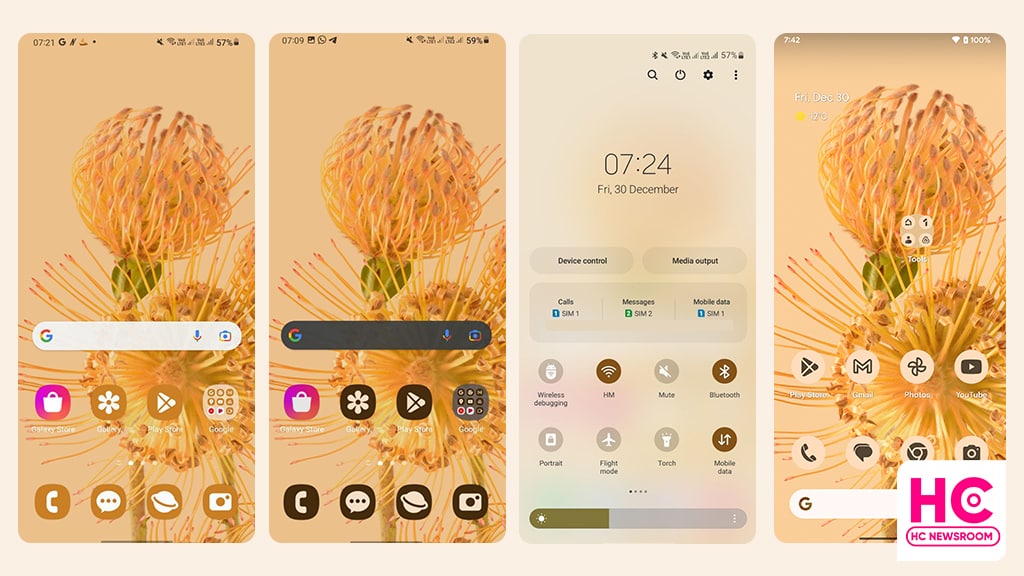
2022 is the year of Android 13 and Android phone makers spotted sending this software update with improved dynamic theme options, but as a babyface, it seems like Samsung still has not learned the core concepts of the dynamic theme.
Introduced with Android 12, the Material You powered dyanamic theme brings brand new settings to tweak the user interface. Instead of being just a feature, the dynamic theme became a part of Android’s soul. With Android 13, Google further polished the dynamic theme so it could be adapted to all Android devices.
Dynamic Theme (Simple version): Once you apply a new wallpaper, the phone generates a range of colors based on that wallpaper. The set of colors is called a color palette and it is then applied throughout the user interface.
Following the decline of Huawei, Samsung is enjoying unlimited Android prowess. It’s projected as a major Android promoter and a babyface. And why not? After all, the South Korean phone maker keeps on posting new mobile shipment records.
However, the handling of the dynamic theme in One UI 5 (which is based on Android 13) shows that Samsung wasn’t serious about being an Android babyface in 2022.
You may want to know, how I reached this conclusion and why Samsung is a failure when it comes to precise work. Let’s find out together.
Appearance:
The user interface is all about appearance, and so does the dynamic theme. Using the dynamic theme on Samsung One UI 5 is different from stock Android 13.
Note: I’ve used the same pixel wallpaper on both Samsung and Pixel devices. So, we can keep the comparison on the same level.
Home Screen:
Below is the home screen, which looks as usual on both One UI 5 and stock Android 13.
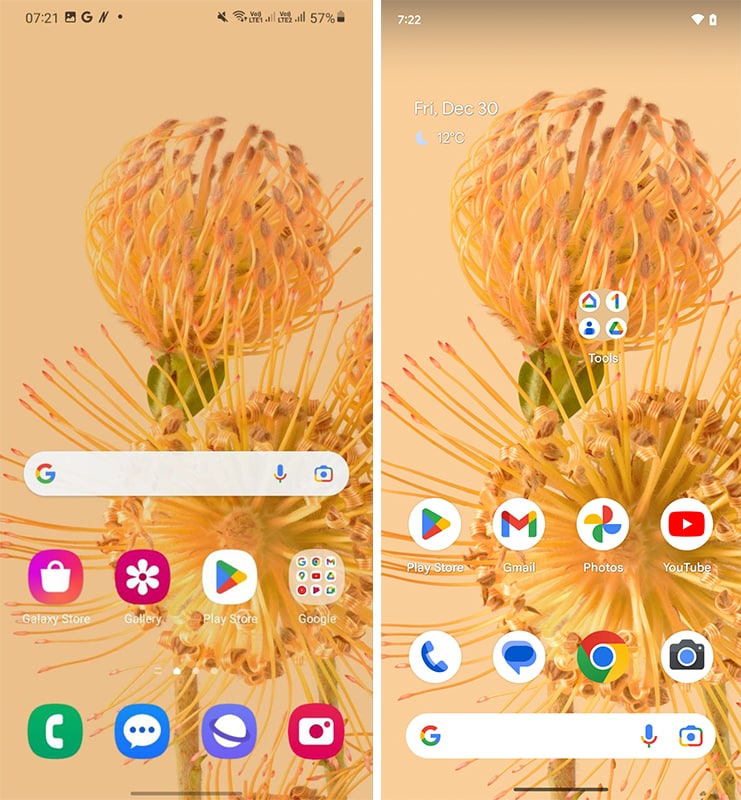
Quick Settings:
Both of the quick settings are using Material You in elements, such as quick access icons and sliders. However, the background on stock Android 13 is solid and remains black. On the other hand, Samsung uses a translucent background in the quick settings, which has not changed even with the Android 13. It is Samsung’s way of implementing features. While in some scenarios, this way obstructs the viewing experience.
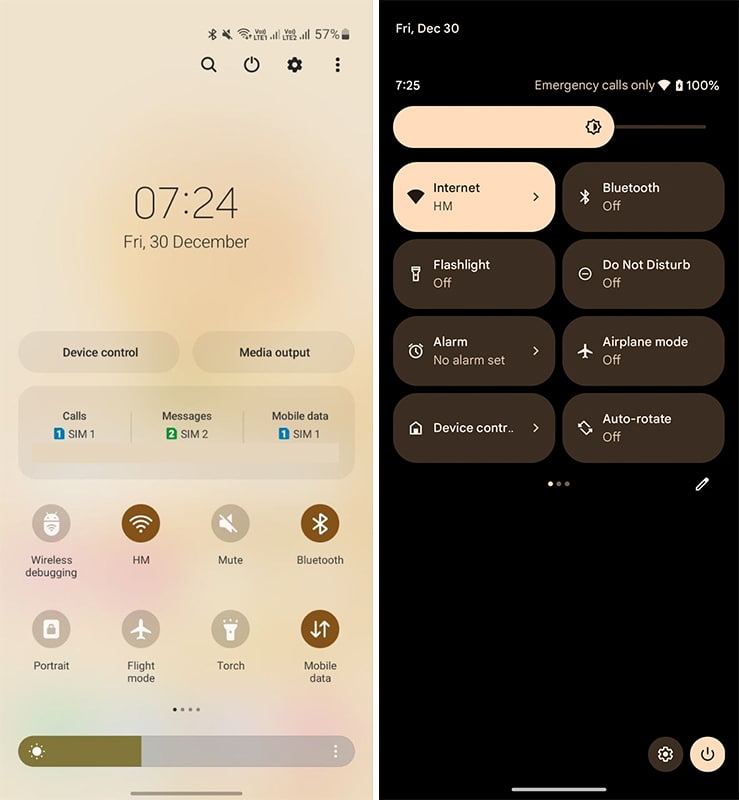
For example, the translucent background is now reflecting the colors of the app opened in the background. It also compromises the look and feel of the quick settings icons and the whole quick settings UI. But it becomes subtle when used on top of the Settings menu.
Below you can check the example of the quick settings opened over the following screens.
(Left – on top of home screen wallpaper, on top of Play Store, on top of Settings menu).
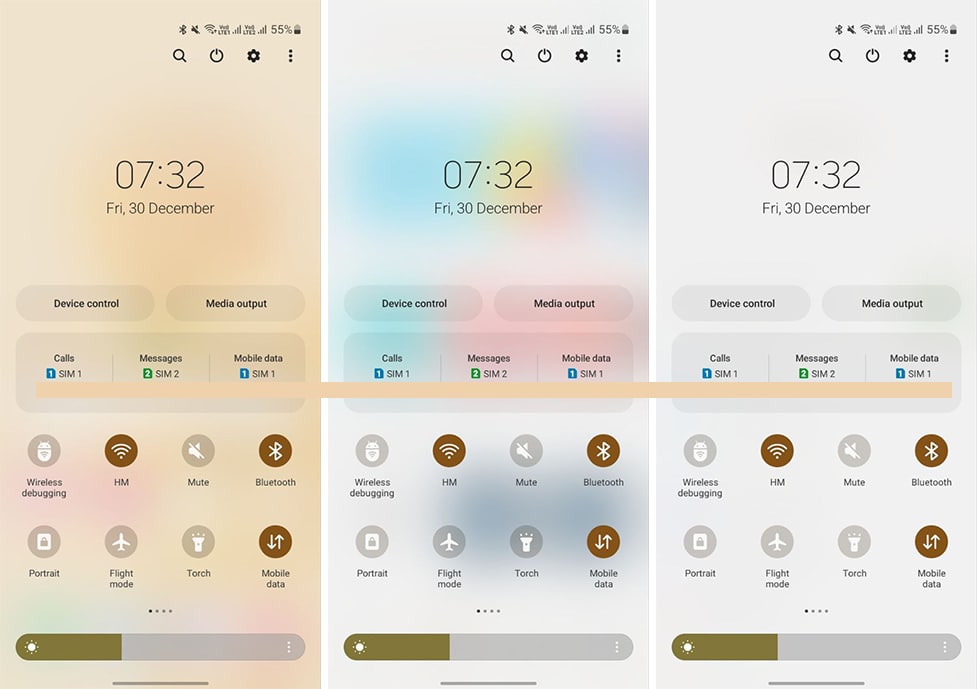
Settings:
The setting is an important part of UI, which we access at least once a day. The layout, font, and elements are different in these two softwares. But Samsung used a slight proportion of the color palette in the Settings’ background and remain neutral for applying to the rest of the user interface.
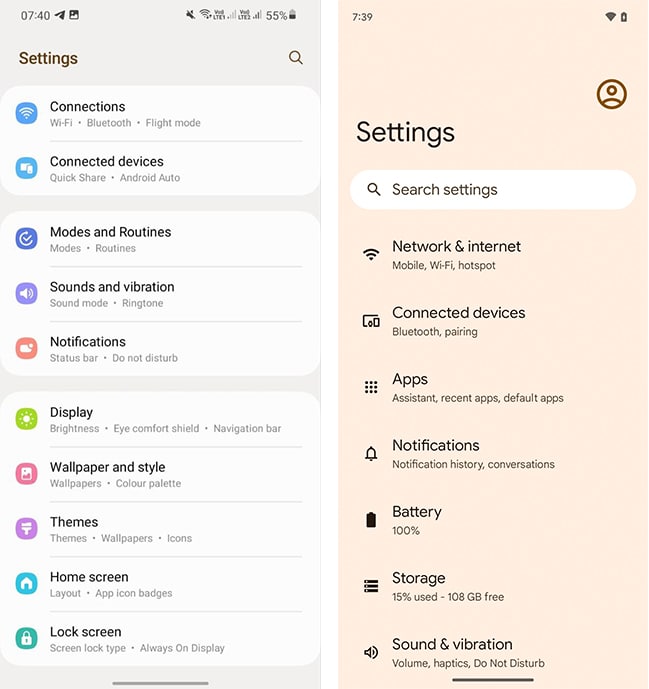
Themed Icons:
I love themed icons because it brings a new look to the app icons. However, Samsung’s way of doing things is a little more disappointing than what it actually looks.
Below you can check Samsung One UI icons painted with color pallets alongside stock android icons. The use and management of contrast in the background and tint on the shape (size too) are super lazy on One UI app icons.
On the flip side, stock Android gets these things done in the best way possible.
![]()
There’s further inspection on this available, apply Dark Mode and see the change.
![]()
Verdict:
We don’t need to explain the results. But It is certainly not nice to implement the dynamic theme for the Android babyface Samsung in 2022.
What could’ve happened?
If possible, Samsung should’ve to blend more into the material rather than bleed into the material. Improve icons, and check visibility levels of the UI elements and the current issues may resolve to an extent.
Android
MagicOS 7/Android 13 beta rolling out for Honor phones
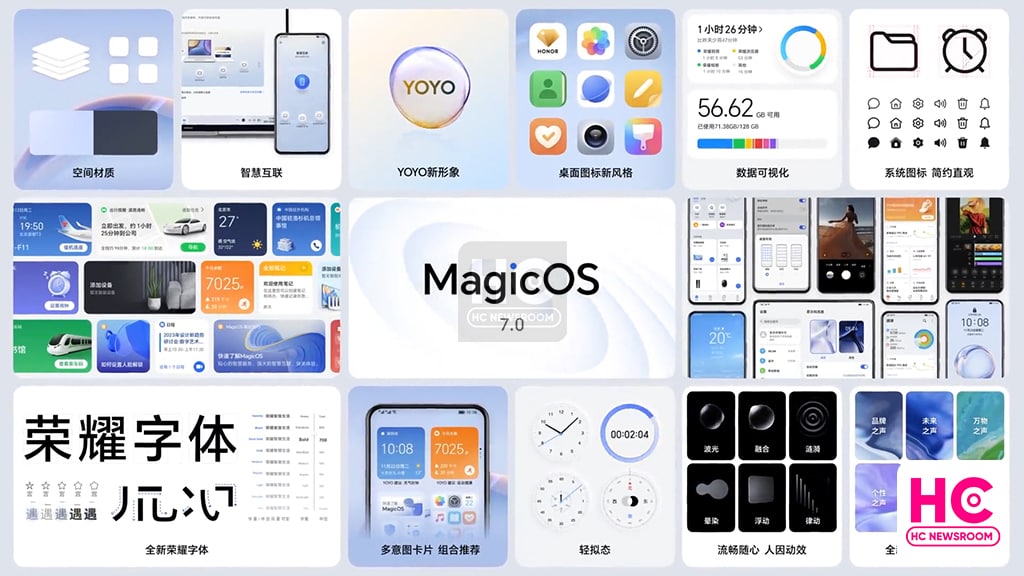
Last month, Honor announced Android 13 based MagicOS 7 and its beta is now rolling out for several models. The rollout is confirmed on various models mentioned in the official roadmap.
According to the information, Honor MagicOS 7 is released for closed beta testers and selected participants will move to public beta in the next phase. After completing the beta test, Honor will send stable MagicOS 7.
Let’s look into the models and their corresponding Honor MagicOS 7/Android 13 beta versions:
Honor Magic V:
The phone is receiving MagicOS 7.0.0.101 upgrading from Magic UI 6.0.0.185.
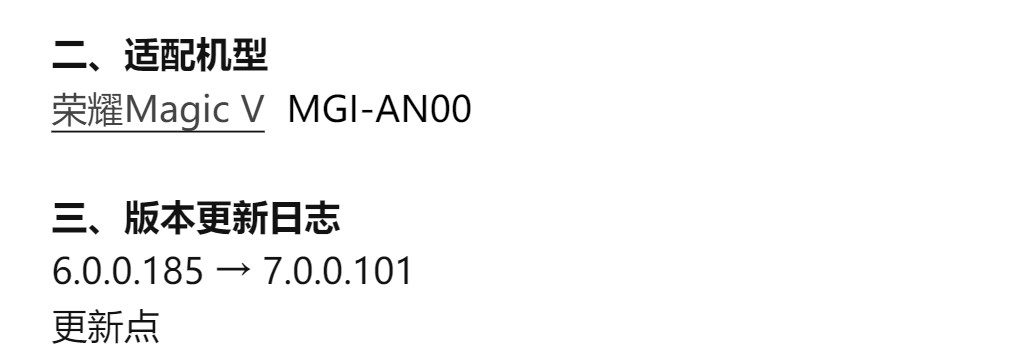
Honor Magic 3 Series:
Honor Magic 3, Magic 3 Pro, and Magic 3 Supreme Edition are receiving MagicOS 7.0.0.107 upgrading from Magic UI 6.0.0.139.
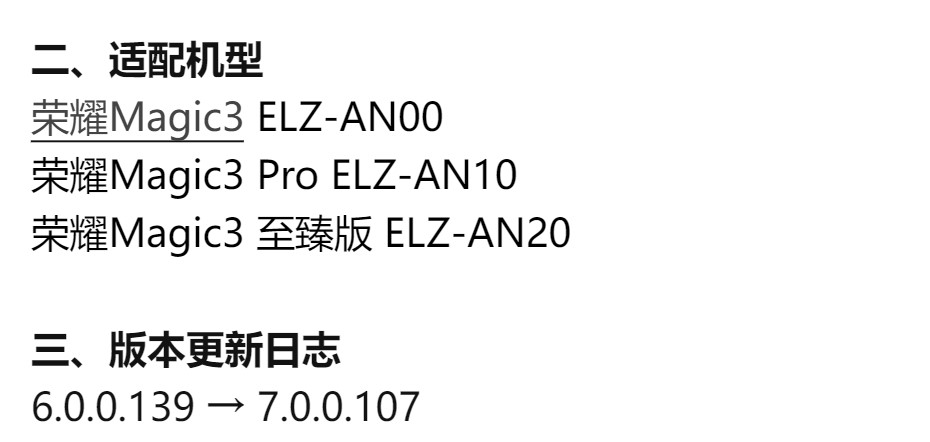
Honor Magic 4 Series:
Honor Magic 4, Magic 4 Pro, and Magic 4 Supreme Edition getting MagicOS 7 version 7.0.0.108 version upgrading from Magic UI 6.0.0.178.
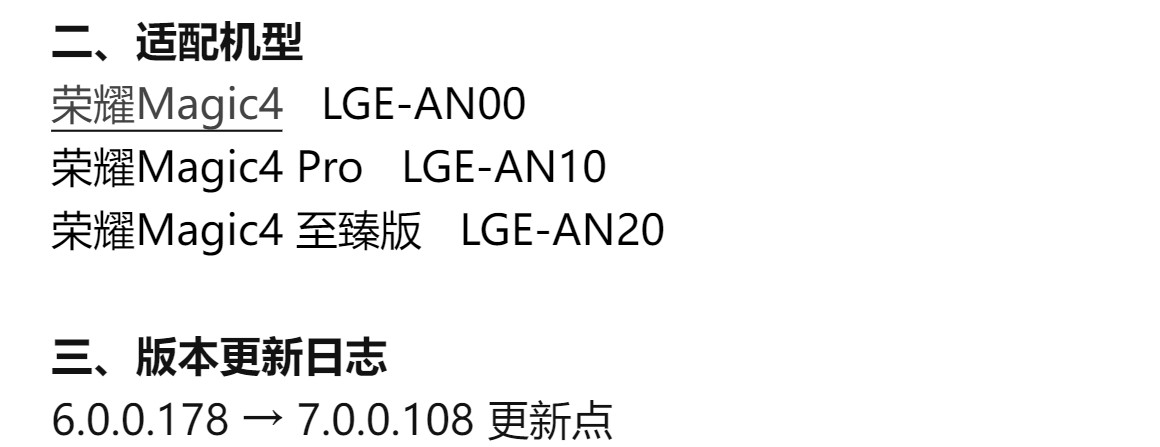
Honor V40:
Honor V40 series is also eligible to download MagicOS 7 closed beta with version 7.0.0.121 users will have to download Magic UI 4.0.0.201 and 205 to participate in the beta activity.
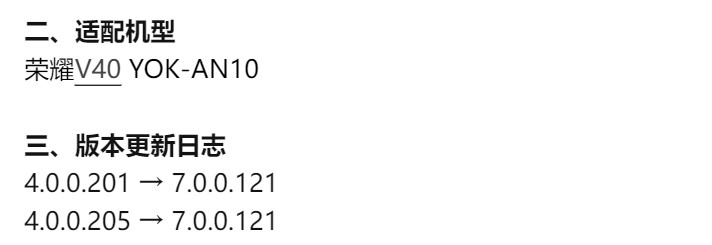
MagicOS 7:
Honor MagicOS 7.0 is a people-centered intelligent interconnection ecosystem, it continues to improve AI Services. The software is also released with a personalized OS, protects privacy and security proactively, and updated the accessibility operation.
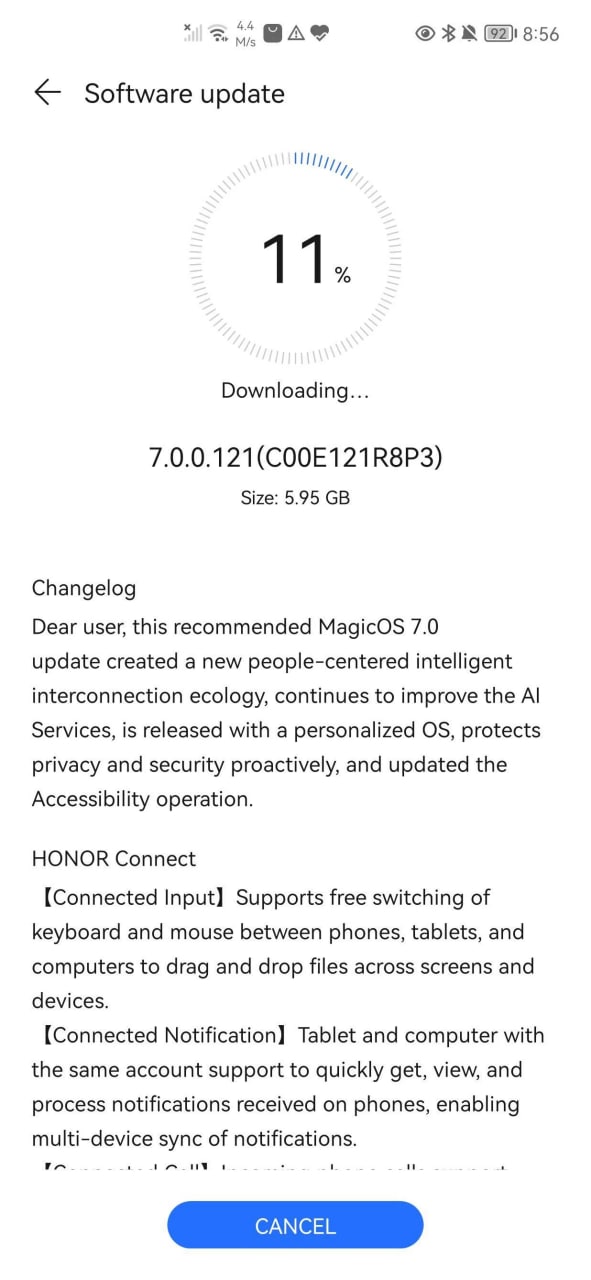
Beta:
It’s noted that the active rollout is spreading as Log and Nolog software packages.
Global:
Currently, Honor is conducting these beta activities in China and it may soon open for global users of these devices.
Notes:
- All of the eligible Honor smartphone owners must have to download the required firmware version before upgrading to MagicOS 7 closed beta.
- During the closed beta testing, users are recommended to join the software user experience improvement program. You can report or suggest features to support closed beta testing environments.
- This software update won’t erase your data but it’s recommended for you to make a backup of important files.
- Users are suggested to update system apps to meet the compatibility.

